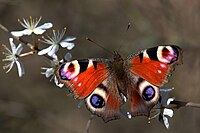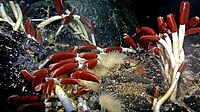
Use of Bacteriophages to Control Vibrio Contamination of Microalgae Used as a Food Source for Oyster Larvae During Hatchery Culture
Sign Up to like & getrecommendations! Published in 2020 at "Current Microbiology"
DOI: 10.1007/s00284-020-01981-w
Abstract: Cultured microalgae are the primary food source for oyster larvae during hatchery culture and are a potential vector for Vibrio spp. infection of larval cultures. Bacteriophages have shown potential for controlling contamination of Vibrio spp.… read more here.
Keywords: microalgae; source oyster; vibrio; food source ... See more keywords

Same, same but different!—matching entomological traces to a human food source by stable isotope analysis
Sign Up to like & getrecommendations! Published in 2017 at "International Journal of Legal Medicine"
DOI: 10.1007/s00414-017-1753-9
Abstract: Blow flies are important tools in forensic entomology, as they feed and develop on human bodies. This fact can be used to estimate the minimum post mortem interval (PMImin), by classifying the age of the… read more here.
Keywords: isotope; food source; adult flies; entomological traces ... See more keywords

First molecular evidence of frogs as a food source for sand flies (Diptera: Phlebotominae) in Brazilian caves.
Sign Up to like & getrecommendations! Published in 2021 at "Parasitology research"
DOI: 10.1007/s00436-021-07154-3
Abstract: Genus and species of phlebotomine sand flies have been recorded and described in caves in Brazil, but no study has provided the food source used by sand flies in these environments. Herein, we identified the… read more here.
Keywords: sand; sand flies; food source; brazilian caves ... See more keywords

Halophilic bacteria as a food source for the brine shrimp Artemia
Sign Up to like & getrecommendations! Published in 2019 at "Aquaculture"
DOI: 10.1016/j.aquaculture.2018.10.068
Abstract: Abstract Artemia cysts are highly demanded by the aquaculture industry to be hatched into nauplii and used as live food for larvae of most farmed fish and shellfish species. In recent years, pond production of… read more here.
Keywords: food source; halophilic bacteria; biomass; artemia ... See more keywords

Self-generated microbial population or cultured microflora – an important criterion toward development of an effective and economically viable road map for organic soil management
Sign Up to like & getrecommendations! Published in 2017 at "Archives of Agronomy and Soil Science"
DOI: 10.1080/03650340.2016.1228882
Abstract: ABSTRACT Huge depletion of soil microflora under conventional farming practice has become the primary contributory factor toward the present depletion of soil and crop productivity. Reconstitution of soil microbial dynamics has been identified as the… read more here.
Keywords: food source; self generated; soil; crop ... See more keywords

The potential of insects as food sources – a review
Sign Up to like & getrecommendations! Published in 2019 at "Critical Reviews in Food Science and Nutrition"
DOI: 10.1080/10408398.2019.1703170
Abstract: Abstract Entomophagy is a long-time practice and a food source for many cultures. Still, many societies have abandoned it a long time ago, and regard it as a primal behavior. However, nowadays, the challenge for… read more here.
Keywords: insects; food source; potential insects; insects food ... See more keywords

Influence of visual targets and landmarks on honey bee foraging and waggle dancing
Sign Up to like & getrecommendations! Published in 2018 at "Insect Science"
DOI: 10.1111/1744-7917.12651
Abstract: Animals use diverse sensory stimuli to navigate their environment and to recognize rewarding food sources. Honey bees use visual attributes of the targeted food source, such as its color, shape, size, direction and distance from… read more here.
Keywords: food source; distance; honey; feeder ... See more keywords

Impact of disturbance and dietary shift on gastrointestinal bacterial community and its invertebrate host system.
Sign Up to like & getrecommendations! Published in 2022 at "Molecular ecology"
DOI: 10.1111/mec.16628
Abstract: The gut microbiome is one of the most important sites of host-microbe interactions, however, mechanisms governing the responses of host-associated microbes to changing environmental conditions are poorly understood. To address this, we investigated individual and… read more here.
Keywords: community; food source; salinity; host ... See more keywords

Attribution of global foodborne disease to specific foods: Findings from a World Health Organization structured expert elicitation
Sign Up to like & getrecommendations! Published in 2017 at "PLoS ONE"
DOI: 10.1371/journal.pone.0183641
Abstract: Background Recently the World Health Organization, Foodborne Disease Burden Epidemiology Reference Group (FERG) estimated that 31 foodborne diseases (FBDs) resulted in over 600 million illnesses and 420,000 deaths worldwide in 2010. Knowing the relative role… read more here.
Keywords: food source; attribution; source attribution; world ... See more keywords

Developing algae as a sustainable food source
Sign Up to like & getrecommendations! Published in 2023 at "Frontiers in Nutrition"
DOI: 10.3389/fnut.2022.1029841
Abstract: Current agricultural and food production practices are facing extreme stress, posed by climate change and an ever-increasing human population. The pressure to feed nearly 8 billion people while maintaining a minimal impact on the environment… read more here.
Keywords: food; sustainable food; production; food source ... See more keywords

A Comparative Study of Food Source Selection in Stingless Bees and Honeybees: Scent Marks, Location, or Color
Sign Up to like & getrecommendations! Published in 2020 at "Frontiers in Plant Science"
DOI: 10.3389/fpls.2020.00516
Abstract: In social bees, the choice of food sources is based on several factors, including scent marks, color, and location of flowers. Here, we used similar setups, in which two stingless bee species, Melipona subnitida and… read more here.
Keywords: color; location; food source; scent marks ... See more keywords